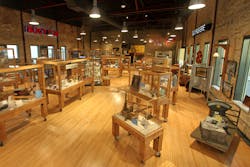After four and a half years, the new Bucyrus Museum opened to the public on August 3, 2021. Since the abrupt closure of the Bucyrus Heritage Museum in 2016, the South Milwaukee Industrial Museum LLC (SMIM) group had to find a new location and obtain the necessary funding and donations to resume public display of Bucyrus’ history and artifacts.
The majority of the display artifacts were donated to SMIM by Caterpillar in 2017. After almost two years of discussion, a partnership with the City of South Milwaukee, a local catering firm, and the Bucyrus Foundation was completed. The target building was the home of the Bucyrus Club from 1920 through 1994. Prior to that, from 1907 to 1919, Bucyrus used it as a small parts machine shop, small valve and pipe assembly, inventory storage, and most notably as their steam engine assembly floor. Many of the steam engines used in the Panama Canal shovels, pile drivers, dredges, and railroad wrecking cranes were built on the first floor.
When the South Milwaukee Bucyrus plant expansion of 1919 made room for these functions on the east side of the railroad tracks, chairman William Coleman ordered an employee club and cafeteria be built. Most of the third floor was removed to make high enough ceilings for a gymnasium, stage, and handball court that consumed the entire second floor area. The steam engine bay became the cafeteria and kitchen, with the machine shop being split up into a retiree’s room, billiard room, bar, and a six-lane bowling alley.
The building was sold to two different private groups, but suffered extensive water damage from a burst pipe in 2015 and was abandoned.
With the building on the verge of being razed in 2019, SMIM worked with the city to put together a public/private venture including a $1.5 million donation for building renovations from the Bucyrus Foundation. The joint project was announced in February 2020, and work began in the fall with a targeted completion date of August 2021. We were able to move our displays, artifacts, and archives into our new home on the second floor in mid-June. We received several donations that enabled us to hire movers, rent lifts, and hire other necessary skills to get everything in place—including the three-quarter-sized 85B dragline model—by the end of July.
We officially opened as the Bucyrus Museum in August. Our lower-level partner is the Bucyrus Club and Event Center, operated by Skyline Catering. The Museum holds special hours for groups and event guests to enjoy the space and our interactive displays, such as the 1570W Dragline Operator Seat or our 495HR Rope Shovel Simulator.
Public days and groups are hosted by members of our docent team of 22 volunteers, most of whom come from a Bucyrus background and with various careers.
We also have a few one-of-a kind items returning home since re-opening. The Ludeman family donated a large-scale 350H backhoe model built by their father Don, who was B-E’s model maker from 1958 through 1984. Grant Gregory, retired B-E assembly superintendent in Pennsylvania, donated his wooden one-eighth-scale 110T truck crane model that used to grace the lobby of the old Erie plant. At one time, both of these hand-built models traveled the world as part of equipment shows, and they are being restored to be put back on display soon.
We hope this homeward bound trend for artifacts continues.
With no corporate support as a backstop, we’re grateful to be part of The Bucyrus Club’s unique event venue/museum combination to help sustain our mission as a 501(c)(3) nonprofit educational museum. We continue to work with local schools, host class tours, and participate in their career days speaking to students about the world of opportunities in manufacturing and engineering fields. We invite everyone to visit us in our new home.
About the Author
Tom Berry
Tom Berry is archivist for the Historical Construction Equipment Association (HCEA). Information is available at www.hcea. net, or by calling 419.352.5616 or e-mailing [email protected].
